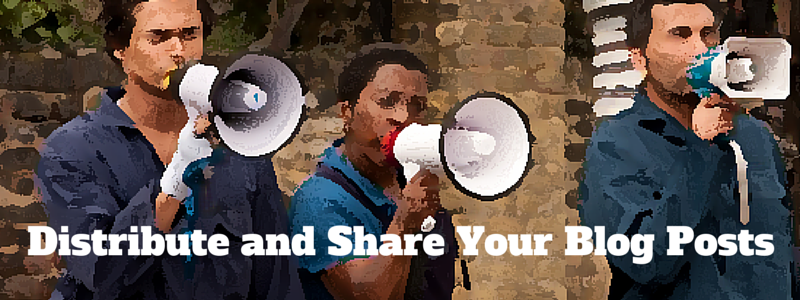
Note: Image adapted from
Garry Knight's photo on flickr.
Having fantastic content on your blog is one thing; getting people to read it is an entirely different task. Posting your content to your blog and hoping readers stumble upon it is a risky bet - one that you’ll probably lose - so when it comes to getting your blog out there, you need to take a
proactive approach to sharing your content.
If you need help attracting loyal and enthused readers to your blog, here is your essential guide to sharing your blog content effectively.
Research Your Audience
Before you decide where and how you want to distribute your content, you should first make sure you know where your audience is hanging out and how they’re reading blogs. Depending on your demographic, you might want to share content via social media or email or a combination of the two.
It will mostly depend on your audience and what information you have from them. If you have more email subscribers than followers on social media, email marketing will probably be best. If neither is strong, you might want to use a third-party site to help give your content a boost.

Why Your SEO Keyword Research Should Be Informed By Your Readers
By Brian Honigman
It’s also important to understand how your audience interacts with technology. Twitter, for example, is more popular with younger users, while Facebook is often better for targeting middle-aged users and retirees. Once you understand your audience, you’ll be better prepared to find them where and when they are most active.
Social Media

Nowadays, it’s hard to find someone who’s not on at least one social media platform. General social media platforms - Facebook, Twitter and Google+ - allow you to share virtually any type of content while more targeted platforms - YouTube, Instagram and LinkedIn - have a specific use in mind.
Let’s take a look at the benefits of some of the more popular platform and see what they can offer you:
Facebook
Considered to be one of the most popular social media sites, Facebook boasts 1.44 billion
monthly active users in the first quarter of 2015. With Facebook, you can post links to your blog content, as well as any images or videos, and share them with all your followers. You can also use Facebook to retarget people who have visited your website previously.
Twitter
With an
average of 236 million users per month, Twitter is great for getting the message out there fast. Just post your link and a short message and your post is shared with all of your followers. The only problem with Twitter is that tweets are very quickly forgotten. Wisecrack estimates that the shelf life of a tweet is just 24 minutes, compared with Facebook’s 90-minute shelf life of a post.
Google+
When Google+ was first released, everyone thought it was the end of Facebook. That didn’t happen, but Google+ does please one entity: Google. Google ranks its own pages higher in search results, so if you have an active Google+ account, post on it and are linking it to your website, you might see some your site appear higher in search results.
LinkedIn
Of all the more specialized social media platforms,
LinkedIn is one of the best sites to share your blog posts, provided the right audience is present. LinkedIn targets professionals, not necessarily consumers. However, if your business is considered B2B, then they might be one of LinkedIn’s 300 million users. If your content is targeted at a more professional crowd, LinkedIn might also be a great option for you.
All of these options make it easier for your followers to not only read your content, but share it as well. They can repost the link itself or send it in a private message to friends, colleagues and family members.
In truth, you can have more than one social media account, but if you don’t have the time to manage all your accounts, none of them will be very effective. Choose one platform you know your audience frequents and then go from there.
Sharing platforms

If social media isn’t your cup of tea, you can always try a blog sharing platform, sometimes called a content syndication network, to get your content noticed. These sites are like the Google Adwords of content. They promote blog posts based on what the user is already reading.
Let’s say you’re reading an article about recent changes to the higher education system in the country on ABCnews.net.au.
Along the side, you see a banner that says “Related content from around the web,” and below it, there is a list of blogs with content about education reform, similar to what you were just reading. This is content syndication.
Your blog is promoted to other people who are already reading similar content, which betters your chances of them clicking on your blog.
Sharing platforms such as
Outbrain and Digesto are also very user-friendly. To use them, simply select the posts you want to promote. You may want to look back at your posts to see which ones had the highest amounts of views or shares. Remember, your posts will be competing against others so put your best foot forward.
Once you choose your posts, track how well they do. You may be able to grow your reach and attract new followers you might not have otherwise reached.
Email Marketing and Marketing Automation

The favorite of many digital marketers, email marketing and marketing automation go hand in hand as the dynamic duo. Using marketing automation, you can build attractive, personalized emails that
target the individual needs of the different demographics of your audience.
Email marketing is a great catch-all for people who aren’t really into social media. Because having an email address is so essential for signing up for Amazon or nearly any online service, you can pretty much guarantee that nearly every one of your consumers will have an email address.
When creating emails to promote your content, remember these simple tips:
-
Use your content title as a subject line. This is your first impression, so tell your readers exactly what you're going to share and get them interested.
- Personalize your emails. Put the receiver’s name in the body or even the subject line, if possible. Your blog is like a dialogue between you and your receiver. Make them feel as if you’re actually talking to them.
- Present the basic problem or topic you’re going to address in the body of your email, and no more. Short and simple is best.
- Always end your email with a call-to-action. Whether you want readers to leave a comment or share the post, encourage them to act.
Text Message Marketing

It may sound strange, but did you know you can share a blog via text? Now that so many consumers are using smartphones to browse the web, you can send out targeted text messages to the phone numbers in your database.
Once they receive the message, readers can click the link, read the blog and share it for themselves.
Like email, text message marketing is opt-in so you can be sure that your message is reaching people who are interested.
If you’re using sign-up forms to grow your email marketing list, ask for phone numbers as well and offer subscribers the chance to receive text message updates. If your updates provide something of value (a great blog or the occasional discount for example), you’ll be sure to keep your subscribers.
Of course, no one likes to be bombarded with text messages, so this form of marketing should be used sparingly or in conjunction with a deal or important reminder. If you’re offering a discount on a service, create a blog post about why that service is so great. Send the blog out with the discount text message to interest buyers and then show them why your service is worth purchasing (at a discounted price, no less!).
Don’t forget to put the “Share This” button and include the “Text” option on your blogs. This will encourage readers to text their friends a link to your blog, and it’s another easy way for your blogs to be shared.
Your Turn
Growing a popular blog takes time. It won’t happen overnight, but if you’re consistent, then your audience will find you. Use the Comments area below to let me know the tactics you use to gain a wider reach for your blog. Thanks for reading.